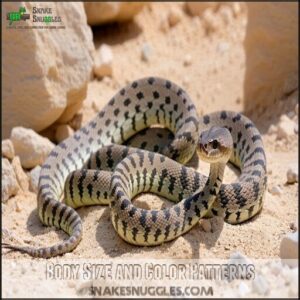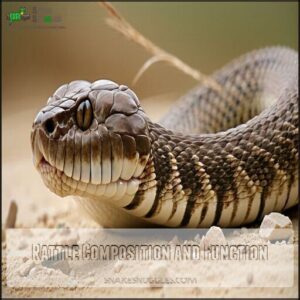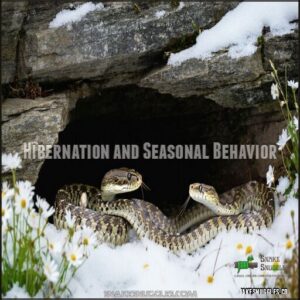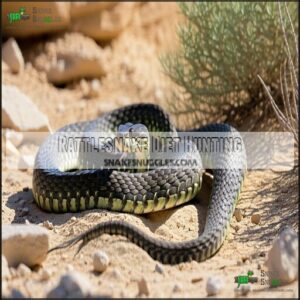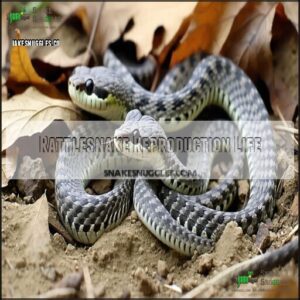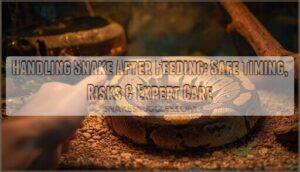This site is supported by our readers. We may earn a commission, at no cost to you, if you purchase through links.
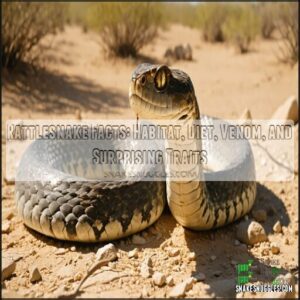 Rattlesnakes are incredible creatures found across the Americas, from deserts to forests.
Rattlesnakes are incredible creatures found across the Americas, from deserts to forests.
Their triangular heads house venom glands and curved fangs designed for hunting, while heat-sensing pits below their eyes let them "see" warm-bodied prey—even in the dark.
The rattle on their tails, made of keratin (like your fingernails), warns predators to back off. They eat mostly rodents, playing a key role in pest control.
Despite their venom, they strike only when threatened. Rattlesnakes give live birth, and their young are independent from day one.
Curious about how they survive harsh climates or evade predators? There’s a lot more to uncover about these creatures, with their ability to see warm-bodied prey and incredible adaptations.
Table Of Contents
- Key Takeaways
- Rattlesnake Physical Traits
- Rattlesnake Habitat Distribution
- Rattlesnake Diet Hunting
- Rattlesnake Reproduction Life
- Rattlesnake Venom Defense
- Frequently Asked Questions (FAQs)
- How long do rattlesnakes live?
- How to identify a rattlesnake by its rattle?
- Are rattlesnakes venomous?
- How big do rattlesnakes get?
- What are 5 interesting facts about rattlesnakes?
- How long can a rattlesnake live?
- Where do rattlesnakes mostly live?
- How far can a rattlesnake jump at you?
- Where do most rattlesnakes live?
- What are some fun facts about rattlesnakes?
- Conclusion
Key Takeaways
- You’ll love that rattlesnakes can "see heat" and strike prey in darkness using their heat-sensing pits.
- Don’t forget their venomous fangs deliver a fast-acting venom tailored for immobilizing prey and digestion.
- They play a key role in rodent control, helping maintain ecological balance in their habitats.
- Rattlesnakes give live birth, and their self-sufficient young are equipped with venom and ready to hunt.
Rattlesnake Physical Traits
You’ll recognize a rattlesnake by its thick, muscular body, diamond-shaped head, and intricate patterns that help it blend into its surroundings.
A rattlesnake’s muscular body and diamond-shaped head, paired with intricate patterns, make it a master of stealth in its surroundings.
Equipped with heat-sensing pits, hollow fangs, and a keratin rattle, these snakes are full of fascinating adaptations, including their ability to blend in, which is aided by their intricate patterns.
Body Size and Color Patterns
Rattlesnakes showcase fascinating size variation and distinctive patterns.
Adults typically measure 3 to 5 feet, though some snake species grow longer.
Their color camouflage ranges from khaki to pinkish or even greenish-gray, blending with their environment.
Pattern development includes dark diamond shapes and black-and-white tail bands.
Regional differences and sexual dimorphism further influence these snake characteristics, aiding snake identification across habitats.
They also possess heat-sensing pits to detect prey, which is a key feature for their survival and hunting success, and overall adaptation.
Triangle-Shaped Heads and Heat-Sensing Organs
With their triangular heads, rattlesnakes pack sensory superpowers.
Between their eyes and nostrils lie heat-sensing pits, or "pit organs," giving them infrared vision. These Pit Vipers detect warm-blooded prey in darkness, making nocturnal hunting efficient.
Their head shape isn’t just iconic—it houses these sensory adaptations like a secret weapon.
- Key features:
- Detect heat signatures.
- "See" in total darkness.
- Specialized for night hunting.
- Complex brain processing.
- Evolved for stealth precision.
Curved Fangs and Venom Ducts
If you’ve ever wondered how rattlesnakes deliver their venom, it’s all about their solenoglyphous fangs.
These hollow, hinged wonders rotate outward during a strike, injecting venom through ducts like tiny syringes.
Here’s a quick breakdown:
| Feature | Function | Fun Fact |
|---|---|---|
| Fang Rotation | Enables precise strikes | Takes milliseconds to extend |
| Venom Injection | Subcutaneous delivery | Acts fast on prey |
| Venom Composition | Specialized toxins | Adapted per species |
It’s fascinating biology in action, showcasing precise strikes and subcutaneous delivery of venom, which is made up of specialized toxins.
Rattle Composition and Function
Think about rattles as nature’s built-in maracas.
Each rattle segment forms when the snake sheds its skin, like adding a bead to a bracelet. Over time, segments break as older "instruments" wear down.
The tail rattler’s sound warns predators and mimics vibrations. This evolution makes rattles an impressive survival tool, a mix of biology and brilliant acoustics.
- Segment addition: New rattles form with each shed.
- Sound creation: Clicks form—no pebble inside!
Reminder
Rattlesnake Habitat Distribution
You’ll find rattlesnakes across almost every corner of the Americas, from southern Canada all the way to central Argentina.
Found throughout the Americas, rattlesnakes thrive from Canada’s prairies to Argentina’s grasslands, showcasing incredible adaptability across diverse ecosystems.
These adaptable snakes thrive in deserts, forests, grasslands, and even mountainous regions, proving they’re as versatile as they’re fascinating.
Geographic Range in The Americas
Stretching across the Americas, rattlesnakes thrive in diverse regions. From Canada’s prairies to Argentina’s grasslands, their range reflects impressive habitat variation.
Arizona bursts with species diversity, while South America boasts the broadest distribution. Rattlesnake range thrives under various climates, but conservation status fluctuates. Four U.S. states host none—lucky them!
| Region | Highest Species Count | Notable Species | Unique Trait |
|---|---|---|---|
| North America | Arizona | Eastern Diamondback | Largest Rattlesnake |
| South America | Argentina (wide range) | South American Rattlesnake | Most Widespread |
| Great Plains | Alberta to Mexico | Prairie Rattlesnake | Vibrations Detection |
| No Rattlesnakes | Hawaii, Alaska, Maine, RI | N/A | Excluded From Range |
Preferred Ecosystems and Environments
Rattlesnake habitats are surprisingly diverse. They thrive in arid habitats like deserts, yet forest dwellers adapt to shaded areas with thick vegetation.
Some species prefer higher altitudes, while others stick closer to water for prey. With urban adaptation increasing, they’ve even been spotted near cities.
Habitat loss challenges their survival, but their wide rattlesnake range shows their impressive adaptability. You can find products for habitats online.
Adaptation to Diverse Climates
Rattlesnakes thrive in habitats ranging from scorching deserts to chilly mountains.
Their arid adaptations, like conserving water and regulating body temperature, make desert survival possible. Cold tolerance helps them endure cooler climates.
Key snake adaptations include heat-sensing pits for hunting, while their behavior adjusts to habitat variation, allowing them to survive extreme conditions. Behavioral adaptations are essential for thriving.
- **Heat-sensing pits detect prey in darkness.
- **Cold tolerance supports high-altitude survival.
- **Snake vibrations track ground movement efficiently.
Hibernation and Seasonal Behavior
During winter dormancy, rattlesnakes brumate—a light hibernation where they conserve energy.
Snake behavior shifts as rattlesnakes migrate to dens, often shared with other snakes.
Seasonal behavior revolves around temperature regulation, with activity patterns increasing during warmer months.
Brumation ends as spring ignites the mating season, showcasing fascinating seasonal snake behavior driven by survival and reproduction needs.
Nature’s rhythm guides rattlesnake life!
Rattlesnake Diet Hunting
You’ll be amazed by how rattlesnakes expertly use their heat-sensing pits and sharp instincts to hunt prey with precision.
By combining ambush tactics and a keen sense of smell, they play a pivotal role in keeping rodent populations under control.
Primary Prey Species and Hunting Techniques
A rattlesnake’s diet relies heavily on rodent predation, supported by its unique ambush tactics.
It waits patiently, striking prey with incredible speed—often within half a second—injecting venom to immobilize victims.
Small mammals like mice dominate the snake diet, though birds and lizards feature, too.
Those interested in rattlesnake feeding options may find a variety of choices.
Once captured, prey is swallowed whole, and acidic gastric fluids handle digestion, taking several days, which is a key part of the rattlesnake feeding process and its unique ambush tactics.
Use of Heat-Sensing Organs and Ambush Predation
You might wonder how rattlesnakes locate prey so effortlessly at night.
Their heat-sensing pits function like built-in night vision, detecting infrared heat from warm-blooded animals. This allows nocturnal hunting success even in darkness.
Using ambush camouflage tactics, they blend into surroundings, remaining still. The sensory organ pinpoints prey movements, ensuring precise attacks.
Predators don’t stand a chance against these highly tuned prey detection methods.
- Heat-sensing pits locate prey using body heat.
- Infrared vision range excels in total darkness.
- Ambush camouflage tactics allow snakes to blend seamlessly.
- Prey detection methods maximize hunting accuracy.
- Heat-sensing organs give an evolutionary hunting edge.
Jacobson’s Organs and Scent Detection
Ever wonder how snakes "smell" the world?
Through tongue flicking, they collect chemical signals from the air.
Their vomeronasal organ, Jacobson’s organ, analyzes these cues, helping with prey identification.
It’s a precise sensory organ, like a built-in radar for scent tracking.
Snakes use their tongue to deliver odor particles to this organ.
| Function | Organ Used | Purpose | Example Task |
|---|---|---|---|
| Scent Tracking | Tongue Flicking | Sense prey movement | Locate rodents |
| Prey Identification | Jacobson’s Organ | Analyze chemicals | Confirm prey type |
| Environmental Scans | Tongue Tips | Detect surroundings | Sense dangers |
| Sensory Processing | Vomeronasal Organ | Decode signals | Navigate habitat |
Role in Controlling Small Mammal Populations
When you think about Ecosystem Balance, rattlesnakes play a leading role.
They regulate small mammal populations, keeping rodents from overrunning habitats. Their diet often includes rats and mice, contributing to natural Rodent Control.
By managing Prey Dynamics, rattlesnakes help maintain a balanced ecosystem.
Without them, agricultural impact could spike as rodent populations soar, disrupting crops and natural environments alike.
Rattlesnake Reproduction Life
You’ll find that rattlesnake reproduction is as fascinating as it’s unique, with females incubating eggs internally and giving live birth to fully formed young.
These baby snakes, born with venom and a single rattle segment, are ready to navigate the world from the start, and possess venom from birth.
Ovoviviparity and Live Birth
Rattlesnake reproduction is fascinating—they’re ovoviviparous, meaning eggs stay inside the mother, allowing for internal incubation.
After about 90 days, baby rattlesnakes, or snakelets, are born fully developed.
Brood size varies from 4–10 on average, with maternal care helping guarantee newborn survival.
This reproductive frequency, typically every two years, makes rattlesnake reproduction an impressive strategy for thriving in challenging environments.
Mating Behaviors and Seasons
Rattlesnake reproduction gets intense! During breeding seasons, males perform dramatic combat dances to win mates, wrestling rivals and showing off strength.
Females use pheromones to signal readiness, ensuring mate selection aligns with nature’s timing. Snake reproduction occurs primarily in spring, with ovoviviparous births.
These unique behaviors highlight fascinating rattlesnake behavior.
- **Mating occurs in spring and autumn.
- **Males engage in combat dances.
- **Females release pheromones to attract mates.
- **Breeding involves fierce male competition.
- **Combat dances determine reproductive success.
Characteristics of Newborn Snakelets
Baby rattlesnakes are born fully equipped for survival.
With venom potency matching adults, they strike with precision. Each snakelet starts life with a “button” for its First Rattle, gaining segments through Early Molting.
Their initial diet consists of small rodents or insects. These tiny rattlesnakes don’t rely on parental care, immediately hunting solo.
Nature’s little marvels, independent from day one, with venom potency and a fully functional rattle, are a testament to their ability to thrive, being fully equipped for survival.
Lifespan and Growth Rate
Surprisingly, a rattlesnake’s lifespan depends on its environment.
On average, wild snakes live 16–22 years but face threats like predators and habitat loss.
Growth slows with age, meaning larger rattlesnakes might molt less than once yearly.
Key growth factors include:
- Rattle Growth: One segment added per molt.
- Sexual Maturity: Reached at 4–5 years.
- Environmental Impact: Critical for survival.
Rattlesnake Venom Defense
Rattlesnakes use their venom, heat-sensing pits, and lightning-fast strikes to defend themselves and capture prey with deadly precision.
Their rattles and advanced sensory tools warn threats to back off, proving these snakes are built for survival with deadly precision.
Venom Composition and Medical Significance
Rattlesnake venom is a complex cocktail of over 50 proteins, including metalloproteinases, which prevent blood clotting.
This venom doesn’t just cause tissue damage—it’s studied for medical applications like antivenom production and pharmaceutical drugs.
Understanding venom toxicity helps improve snake bite treatment.
Researchers can acquire specialized research products for their work.
Ongoing venom research aims to uncover life-saving treatments derived from this dangerous yet fascinating natural substance.
Structure and Function of The Rattle
You know the iconic rattlesnake rattle? It’s a genius instrument of nature.
Here’s the breakdown:
- Rattle Mechanics: It’s made of keratin, like your nails.
- Segment Growth: New segments form every time they shed.
- Tail Vibration: Rapid movements create the buzzing sound.
- Sound Frequency: The noise warns threats and startles prey.
The rattle’s keratinized rings interlock for unique movement.
Nature’s noisemaker, perfected.
Heat-Sensing Loreal Pits and Infrared Vision
Not just venom, but the heat-sensing loreal pits make rattlesnakes remarkable.
These pit organs detect heat signature perception of prey, even in darkness.
Acting like built-in infrared cameras, they send neural impulse transmissions to the brain, showcasing evolutionary advantages.
Pit vipers, including rattlesnakes, master infrared detection range to hunt efficiently.
Snake facts like this prove nature’s ingenuity.
Strike Range and Capabilities
A rattlesnake’s strike is impressively fast and precise. With speeds up to five-tenths of a second, these venomous snakes deliver venom injection with remarkable target accuracy.
Their bite force isn’t crushing but pairs with curved fangs for efficiency.
Here’s how they strike effectively:
- Aligns head for defensive strikes.
- Uses heat-sensing pits.
- Employs quick muscle contractions.
- Injects venom into prey or threats.
Frequently Asked Questions (FAQs)
How long do rattlesnakes live?
A rattlesnake’s lifespan ranges from 16 to 22 years in the wild, depending on species and environment.
They live longer in captivity since they’re safe from predators, harsh weather, and the hazards of hunting prey.
How to identify a rattlesnake by its rattle?
Distinctive buzzing builds from dry, keratin segments rubbing together at the tail’s tip.
A rattlesnake’s rattle feels like nature’s maraca, signaling danger—trust it.
Its worn, layered segments create unique vibrations, unmatched by harmless snakes, making the rattlesnake’s rattle a distinctive warning sign.
Are rattlesnakes venomous?
Yes, they’re venomous!
Rattlesnakes deliver venom through hollow fangs, like nature’s syringes.
Their venom can immobilize prey and help digest meals, but it’s also dangerous to humans—so keep your distance and respect their space!
How big do rattlesnakes get?
Imagine spotting a coiled shadow in the brush—rattlesnakes range from 5 to 5 feet long, depending on the species.
Their size makes them incredible hunters, but thankfully, they mostly avoid humans unless provoked.
What are 5 interesting facts about rattlesnakes?
You’ll find rattlesnakes fascinating.
They use heat-sensing pits to “see” warm prey in darkness, inject venom through hollow fangs.
They grow a new rattle segment with each shed, detect vibrations without ears.
They avoid humans unless threatened, and these behaviors make them fascinating creatures.
How long can a rattlesnake live?
Think of time as a coiled snake—rattlesnakes can live 16 to 22 years in the wild.
Their lifespan depends on factors like predators, habitat, and food, but they thrive when left undisturbed in nature.
Where do rattlesnakes mostly live?
Rattlesnakes mostly live in deserts, grasslands, forests, and rocky areas across North and South America.
You’ll find the most species in Arizona, but they avoid four states: Alaska, Hawaii, Maine, and Rhode Island.
How far can a rattlesnake jump at you?
A rattlesnake won’t really “jump” at you, but it can strike up to half its body length in milliseconds.
If it’s 4 feet long, expect a 2-foot strike, fast and precise!
Where do most rattlesnakes live?
You’ll find most rattlesnakes thriving in the deserts and grasslands of the southwestern United States and northern Mexico.
They also live in forests, rocky hillsides, and prairies, adapting to diverse environments across North and South America.
What are some fun facts about rattlesnakes?
You’ll love this: rattlesnakes can "see" heat, thanks to special pits on their faces.
They shed skin multiple times yearly, adding rattle segments.
And surprisingly, they’re great swimmers, crossing rivers and lakes with ease!
Conclusion
Rattlesnakes are nature’s fascinating survivalists, blending sharp senses with unique traits.
Their heat-sensing pits, venomous fangs, and keratin rattles help them thrive in deserts, forests, and beyond.
By hunting rodents, they play a pivotal role in pest control and ecological balance.
Their live births and self-sufficient young add to their incredible adaptability.
While their venom demands respect, they aren’t out to harm unless provoked.
Exploring rattlesnake facts reveals how these reptiles balance resilience and ecological importance.

